Peugeot Boxer 2016 Owners Manual
Manufacturer: PEUGEOT, Model Year: 2016, Model line: Boxer, Model: Peugeot Boxer 2016Pages: 292, PDF Size: 10.07 MB
Page 91 of 292
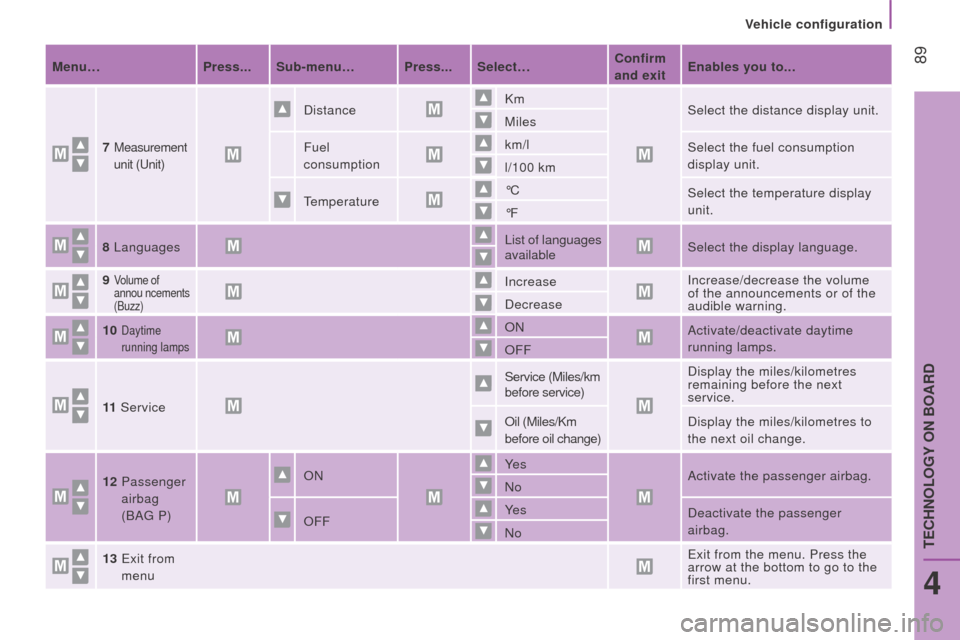
89
boxer_en_Chap04_technologie-a-bord_ed01-2015
Menu… Press... Sub-menu… Press... Select…c onfirm
and exit Enables you to...
7
Measurement
unit (u nit)
Distance Km
Select the distance display unit.
Miles
Fuel
consumption km/l
Select the fuel consumption
display unit.
l/100 km
temperature °C
Select the temperature display
unit.
°F
8 Languages List of languages
availableSelect the display language.
9
Volume of
annou ncements
(Buzz)Increase Increase/decrease the volume
of the announcements or of the
audible warning.
Decrease
10
Daytime
running lampsON Activate/deactivate daytime
running lamps.
OFF
11 Service Service (Miles/km
before service)
Display the miles/kilometres
remaining before the next
service.
Oil (Miles/Km
before oil change) Display the miles/kilometres to
the next oil change.
12
Passenger
airbag
(BA
g
P) ON
Ye s
Activate the passenger airbag.
No
OFF Ye s
Deactivate the passenger
airbag.
No
13
e
xit from
menu
e
xit from the menu. Press the
arrow at the bottom to go to the
first menu.
Vehicle configuration
4
teCHNOLOgY ON BOARD
Page 92 of 292
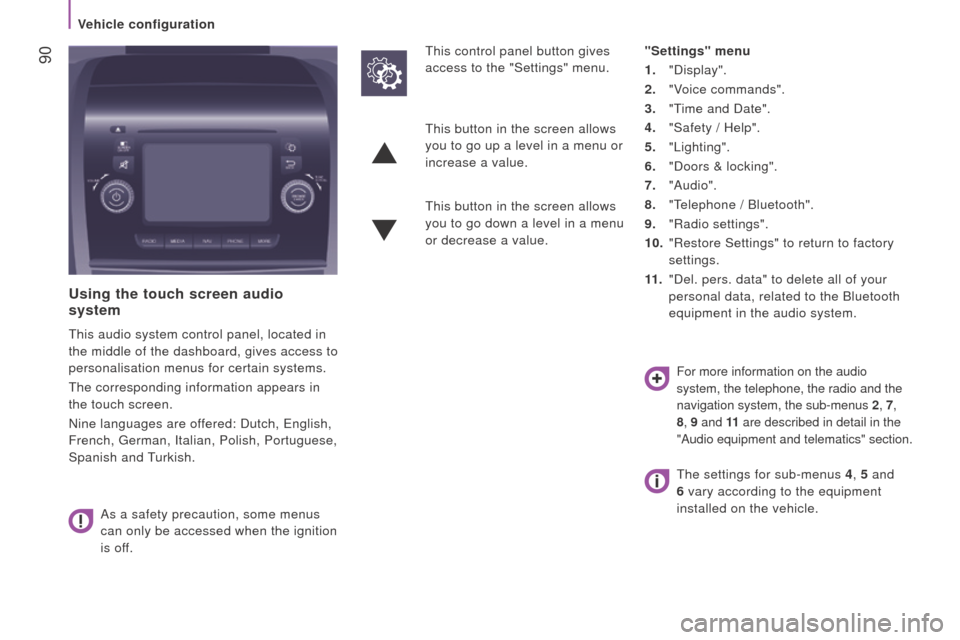
90
boxer_en_Chap04_technologie-a-bord_ed01-2015
using the touch screen audio
system
this audio system control panel, located in
the middle of the dashboard, gives access to
personalisation menus for certain systems.
t
he corresponding information appears in
the touch screen.
Nine languages are offered: Dutch,
e nglish,
French,
g erman, Italian, Polish, Portuguese,
Spanish and
t
urkish.
As a safety precaution, some menus
can only be accessed when the ignition
is off.
t
his control panel button gives
access to the "Settings" menu. "Settings" menu
1. "Display".
2.
"V
oice commands".
3.
"
t
ime and Date".
4.
"Safety / Help".
5.
"Lighting".
6.
"Doors & locking".
7.
"Audio".
8.
"
t
elephone / Bluetooth".
9.
"Radio settings".
10.
"Restore Settings" to return to factory
settings.
11 .
"Del. pers. data" to delete all of your
personal data, related to the Bluetooth
equipment in the audio system.
t
his button in the screen allows
you to go up a level in a menu or
increase a value.
t
his button in the screen allows
you to go down a level in a menu
or decrease a value.
For more information on the audio
system, the telephone, the radio and the
navigation system, the sub-menus
2, 7,
8, 9 and 11 are described in detail in the
"Audio equipment and telematics" section.
the settings for sub-menus 4 , 5 and
6 vary according to the equipment
installed on the vehicle.
Vehicle configuration
Page 93 of 292
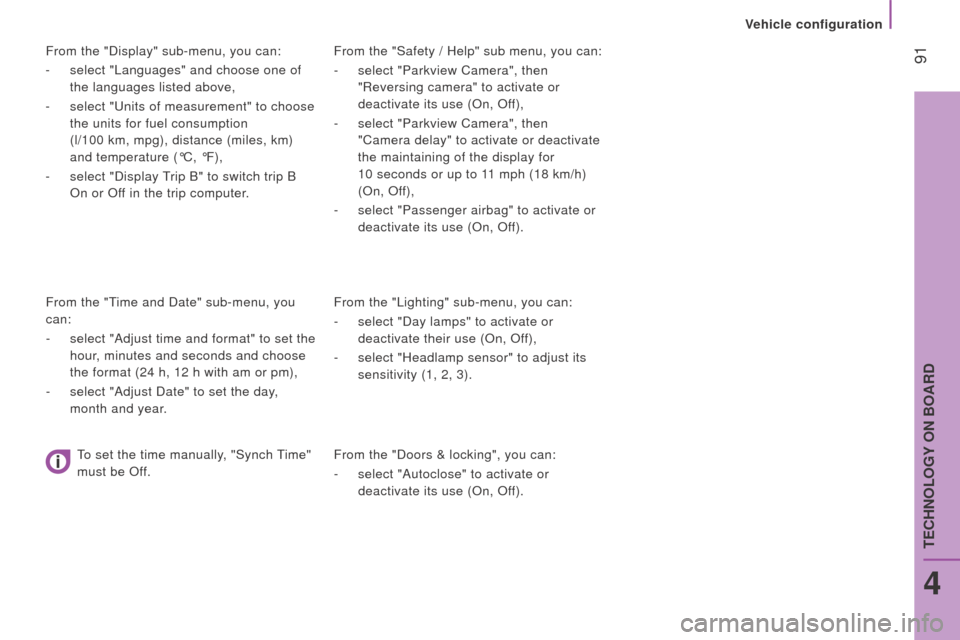
91
boxer_en_Chap04_technologie-a-bord_ed01-2015
From the "Safety / Help" sub menu, you can:
-
select "Parkview Camera", then
"Reversing camera" to activate or
deactivate its use (On, Off),
-
select "Parkview Camera", then
"Camera delay" to activate or deactivate
the maintaining of the display for
10 seconds or up to 11 mph (18 km/h)
(On, Off),
-
select "Passenger airbag" to activate or
deactivate its use (On, Off).
From the "Lighting" sub-menu, you can:
-
select "Day lamps" to activate or
deactivate their use (On, Off),
-
select "Headlamp sensor" to adjust its
sensitivity (1, 2, 3).
From the "Doors & locking", you can:
-
select "Autoclose" to activate or
deactivate its use (On, Off).
From the "Display" sub-menu, you can:
-
select "Languages" and choose one of
the languages listed above,
-
select "
u
nits of measurement" to choose
the units for fuel consumption
(l/100 km, mpg), distance (miles, km)
and temperature (°C, °F),
-
select "Display trip B" to switch trip B
On or Off in the trip computer.
From the "
t
ime and Date" sub-menu, you
can:
-
select "Adjust time and format" to set the
hour, minutes and seconds and choose
the format (24 h, 12 h with am or pm),
-
select "Adjust Date" to set the day
,
month and year.
to set the time manually
, "Synch
time"
must be Off.
Vehicle configuration
4
teCHNOLOgY ON BOARD
Page 94 of 292
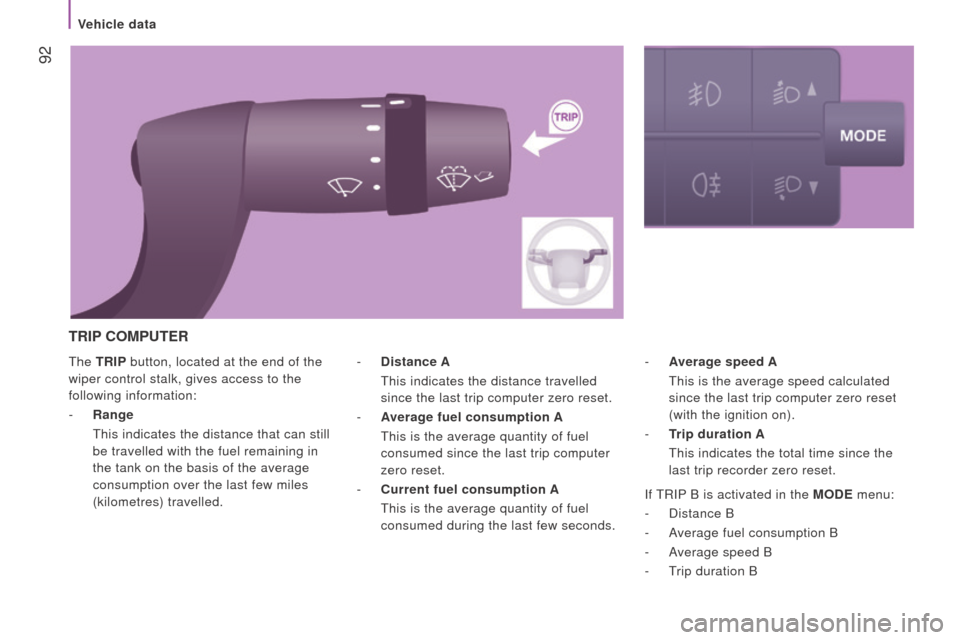
92
boxer_en_Chap04_technologie-a-bord_ed01-2015
the trIP button, located at the end of the
wiper control stalk, gives access to the
following information:
-
r
ange
t his indicates the distance that can still
be travelled with the fuel remaining in
the tank on the basis of the average
consumption over the last few miles
(kilometres) travelled. -
A verage speed A
t his is the average speed calculated
since the last trip computer zero reset
(with the ignition on).
-
t
rip
duration A
t his indicates the total time since the
last trip recorder zero reset.
-
d istance A
t his indicates the distance travelled
since the last trip computer zero reset.
-
A
verage fuel consumption A
t his is the average quantity of fuel
consumed since the last trip computer
zero reset.
-
c
urrent fuel consumption A
t his is the average quantity of fuel
consumed during the last few seconds.
trIP co MP ut E r
If tRIP B is activated in the M od E menu:
-
Distance B
-
A
verage fuel consumption B
-
A
verage speed B
-
t
rip duration B
Vehicle data
Page 95 of 292
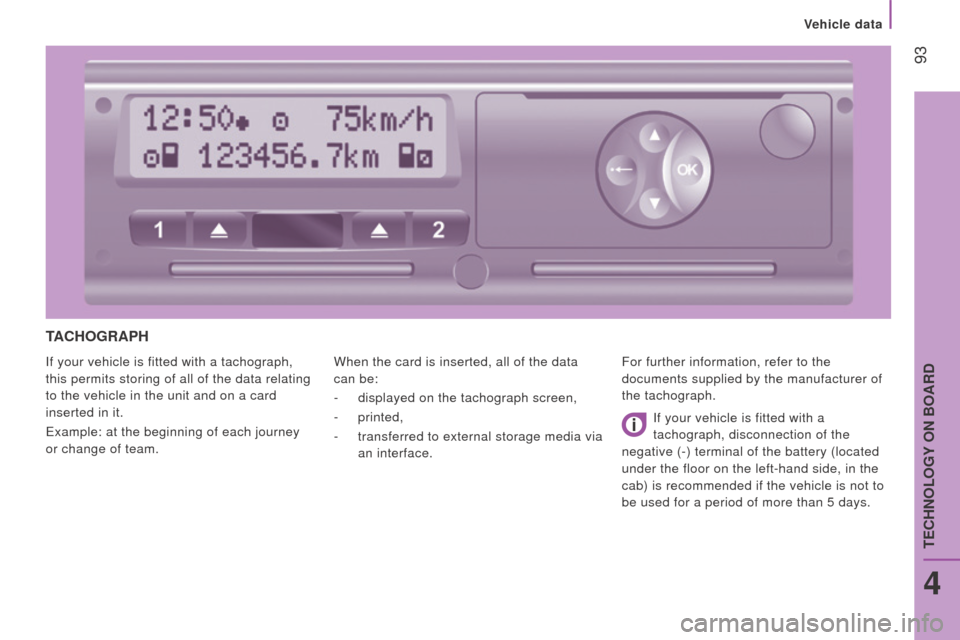
93
boxer_en_Chap04_technologie-a-bord_ed01-2015
tAc H o G r APH
If your vehicle is fitted with a tachograph,
this permits storing of all of the data relating
to the vehicle in the unit and on a card
inserted in it.
e
xample: at the beginning of each journey
or change of team. When the card is inserted, all of the data
can be:
-
displayed on the tachograph screen,
-
printed,
-
transferred to external storage media via
an interface. For further information, refer to the
documents supplied by the manufacturer of
the tachograph.
If your vehicle is fitted with a
tachograph, disconnection of the
negative (-) terminal of the battery (located
under the floor on the left-hand side, in the
cab) is recommended if the vehicle is not to
be used for a period of more than 5 days.
4
teCHNOLOgY ON BOARD
Vehicle data
Page 96 of 292
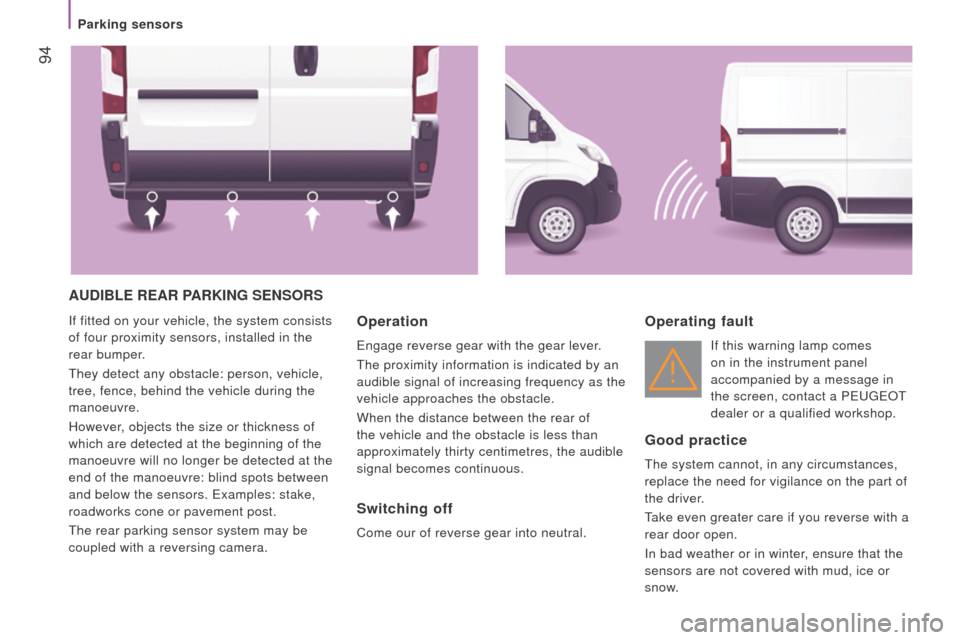
94
boxer_en_Chap04_technologie-a-bord_ed01-2015
AudIBLE rEAr PArKInG SEnSorS
If fitted on your vehicle, the system consists
of four proximity sensors, installed in the
rear bumper.
t
hey detect any obstacle: person, vehicle,
tree, fence, behind the vehicle during the
manoeuvre.
However, objects the size or thickness of
which are detected at the beginning of the
manoeuvre will no longer be detected at the
end of the manoeuvre: blind spots between
and below the sensors.
e xamples: stake,
roadworks cone or pavement post.
t
he rear parking sensor system may be
coupled with a reversing camera.operation
engage reverse gear with the gear lever.
t
he proximity information is indicated by an
audible signal of increasing frequency as the
vehicle approaches the obstacle.
When the distance between the rear of
the vehicle and the obstacle is less than
approximately thirty centimetres, the audible
signal becomes continuous.
Switching off
Come our of reverse gear into neutral.
operating fault
If this warning lamp comes
on in the instrument panel
accompanied by a message in
the screen, contact a P
euge O t
dealer or a qualified workshop.
Good practice
the system cannot, in any circumstances,
replace the need for vigilance on the part of
the driver.
take even greater care if you reverse with a
rear door open.
In bad weather or in winter, ensure that the
sensors are not covered with mud, ice or
snow.
Parking sensors
Page 97 of 292
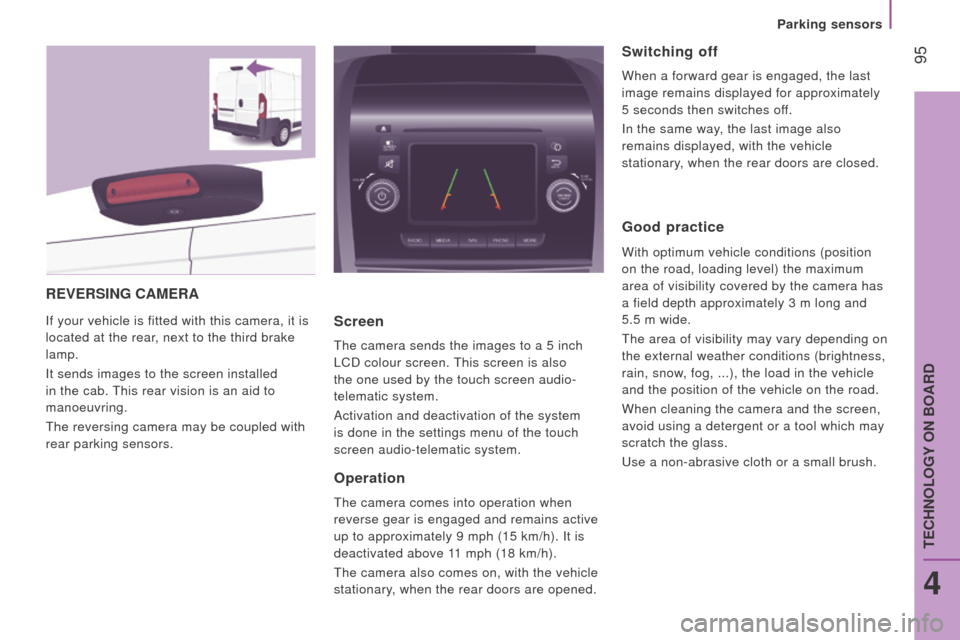
95
boxer_en_Chap04_technologie-a-bord_ed01-2015
rEVErSInG cAMErA
If your vehicle is fitted with this camera, it is
located at the rear, next to the third brake
lamp.
It sends images to the screen installed
in the cab.
t
his rear vision is an aid to
manoeuvring.
t
he reversing camera may be coupled with
rear parking sensors.Screen
the camera sends the images to a 5 inch
LCD colour screen.
t
his screen is also
the one used by the touch screen audio-
telematic system.
Activation and deactivation of the system
is done in the settings menu of the touch
screen audio-telematic system.
operation
the camera comes into operation when
reverse gear is engaged and remains active
up to approximately 9 mph (15 km/h). It is
deactivated above 11 mph (18 km/h).
t
he camera also comes on, with the vehicle
stationary, when the rear doors are opened.
Switching off
When a forward gear is engaged, the last
image remains displayed for approximately
5
seconds then switches off.
In the same way, the last image also
remains displayed, with the vehicle
stationary, when the rear doors are closed.
Good practice
With optimum vehicle conditions (position
on the road, loading level) the maximum
area of visibility covered by the camera has
a field depth approximately 3 m long and
5.5
m wide.
t
he area of visibility may vary depending on
the external weather conditions (brightness,
rain, snow, fog, ...), the load in the vehicle
and the position of the vehicle on the road.
When cleaning the camera and the screen,
avoid using a detergent or a tool which may
scratch the glass.
u
se a non-abrasive cloth or a small brush.
Parking sensors
4
teCHNOLOgY ON BOARD
Page 98 of 292
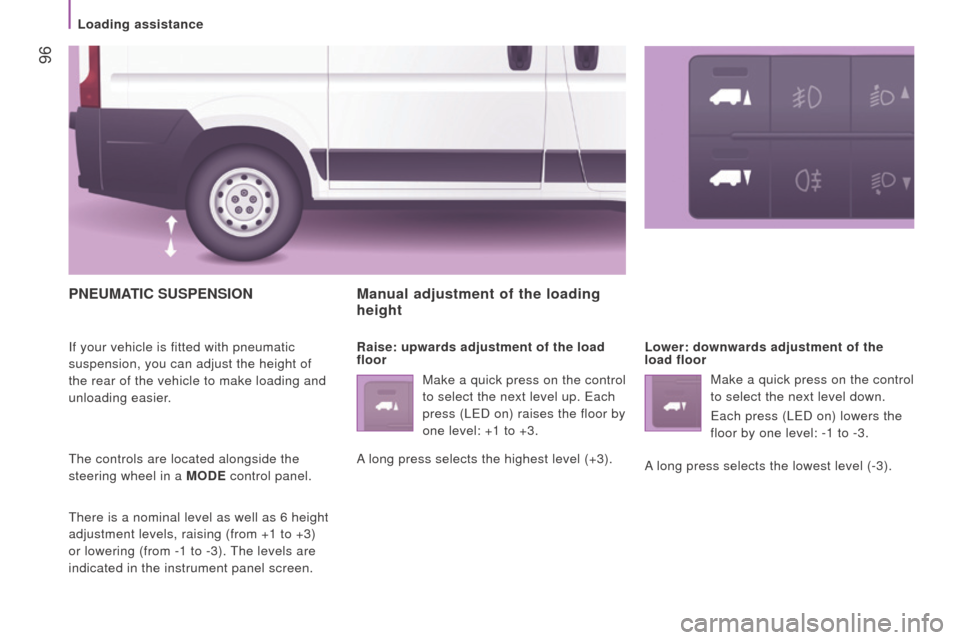
96
boxer_en_Chap04_technologie-a-bord_ed01-2015
PnEuMAtI c S u SPE n SI on
If your vehicle is fitted with pneumatic
suspension, you can adjust the height of
the rear of the vehicle to make loading and
unloading easier.
t
he controls are located alongside the
steering wheel in a M
od E control panel.
t
here is a nominal level as well as 6 height
adjustment levels, raising (from +1 to +3)
or lowering (from -1 to -3).
t
he levels are
indicated in the instrument panel screen.
Manual adjustment of the loading
height
raise: upwards adjustment of the load
floor Lower: downwards adjustment of the
load floor
Make a quick press on the control
to select the next level up.
e ach
press (L
e D on) raises the floor by
one level: +1 to +3.
A long press selects the highest level (+3). Make a quick press on the control
to select the next level down.
e
ach press (L e D on) lowers the
floor by one level: -1 to -3.
A long press selects the lowest level (-3).
Loading assistance
Page 99 of 292
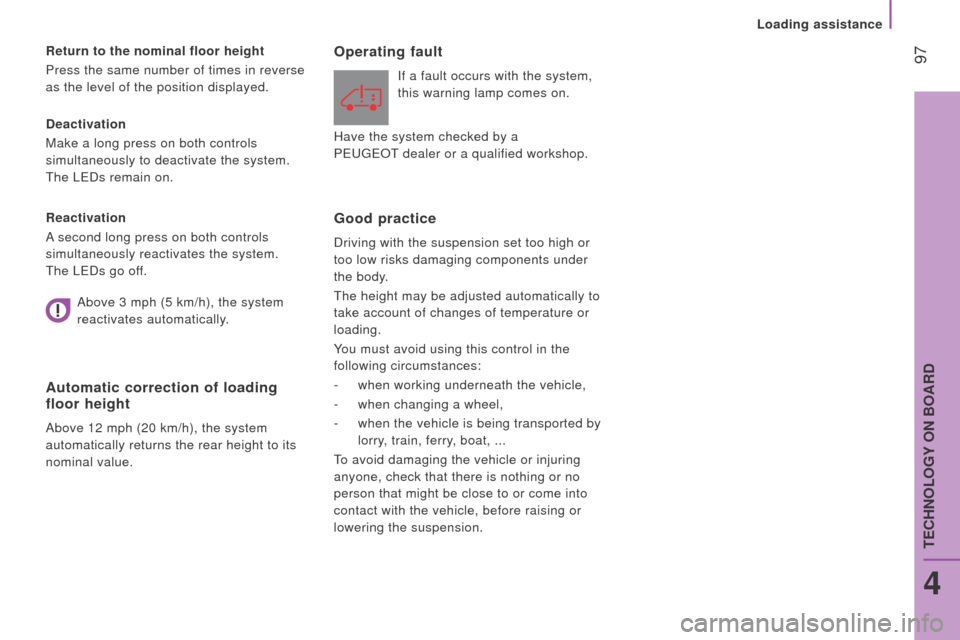
97
boxer_en_Chap04_technologie-a-bord_ed01-2015
deactivation
Make a long press on both controls
simultaneously to deactivate the system.
t
he L e Ds remain on.
r
eturn to the nominal floor height
Press the same number of times in reverse
as the level of the position displayed.
r
eactivation
A second long press on both controls
simultaneously reactivates the system.
t
he L e Ds go off.
Automatic correction of loading
floor height
Above 12 mph (20 km/h), the system
automatically returns the rear height to its
nominal value.
operating fault
If a fault occurs with the system,
this warning lamp comes on.
Good practice
Driving with the suspension set too high or
too low risks damaging components under
the body.
t
he height may be adjusted automatically to
take account of changes of temperature or
loading.
You must avoid using this control in the
following circumstances:
-
when working underneath the vehicle,
-
when changing a wheel,
-
when the vehicle is being transported by
lorry, train, ferry, boat, ...
to avoid damaging the vehicle or injuring
anyone, check that there is nothing or no
person that might be close to or come into
contact with the vehicle, before raising or
lowering the suspension.
Above 3 mph (5 km/h), the system
reactivates automatically.
Have the system checked by a
P
euge O t dealer or a qualified workshop.
Loading assistance
4
teCHNOLOgY ON BOARD
Page 100 of 292
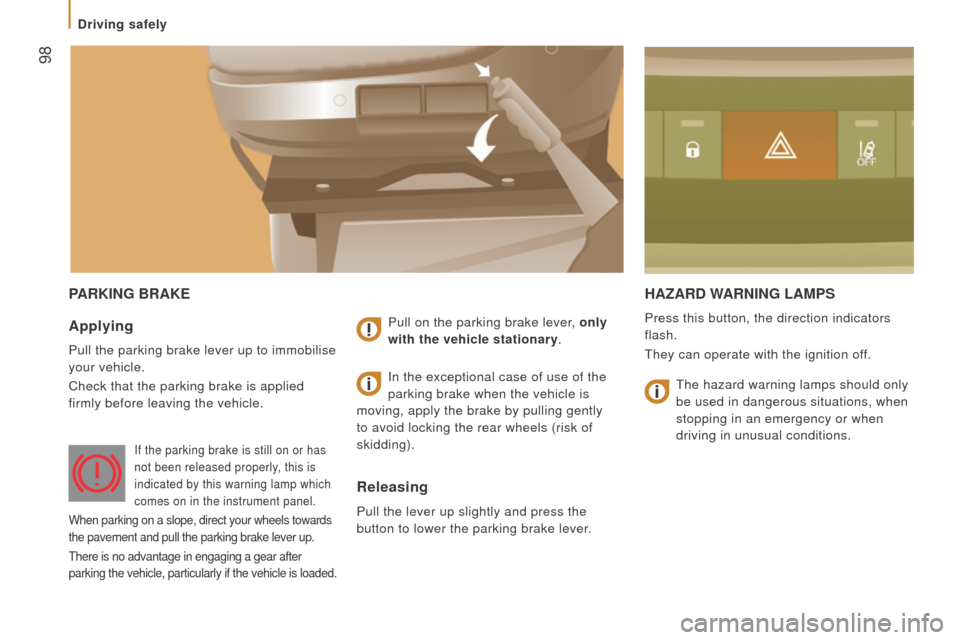
98
boxer_en_Chap05_Securite_ed01-2015
PAr KI n G B r AKEH A z A rd WA rn I n G LAMPS
Press this button, the direction indicators
flash.
t
hey can operate with the ignition off.Applying
Pull the parking brake lever up to immobilise
your vehicle.
Check that the parking brake is applied
firmly before leaving the vehicle. Pull on the parking brake lever, only
with the vehicle stationary.
releasing
Pull the lever up slightly and press the
button to lower the parking brake lever.In the exceptional case of use of the
parking brake when the vehicle is
moving, apply the brake by pulling gently
to avoid locking the rear wheels (risk of
skidding).
If the parking brake is still on or has
not been released properly, this is
indicated by this warning lamp which
comes on in the instrument panel.
When parking on a slope, direct your wheels towards
the pavement and pull the parking brake lever up.
t
here is no advantage in engaging a gear after
parking the vehicle, particularly if the vehicle is loaded.
the hazard warning lamps should only
be used in dangerous situations, when
stopping in an emergency or when
driving in unusual conditions.
Driving safely